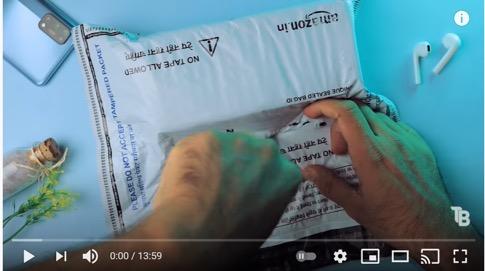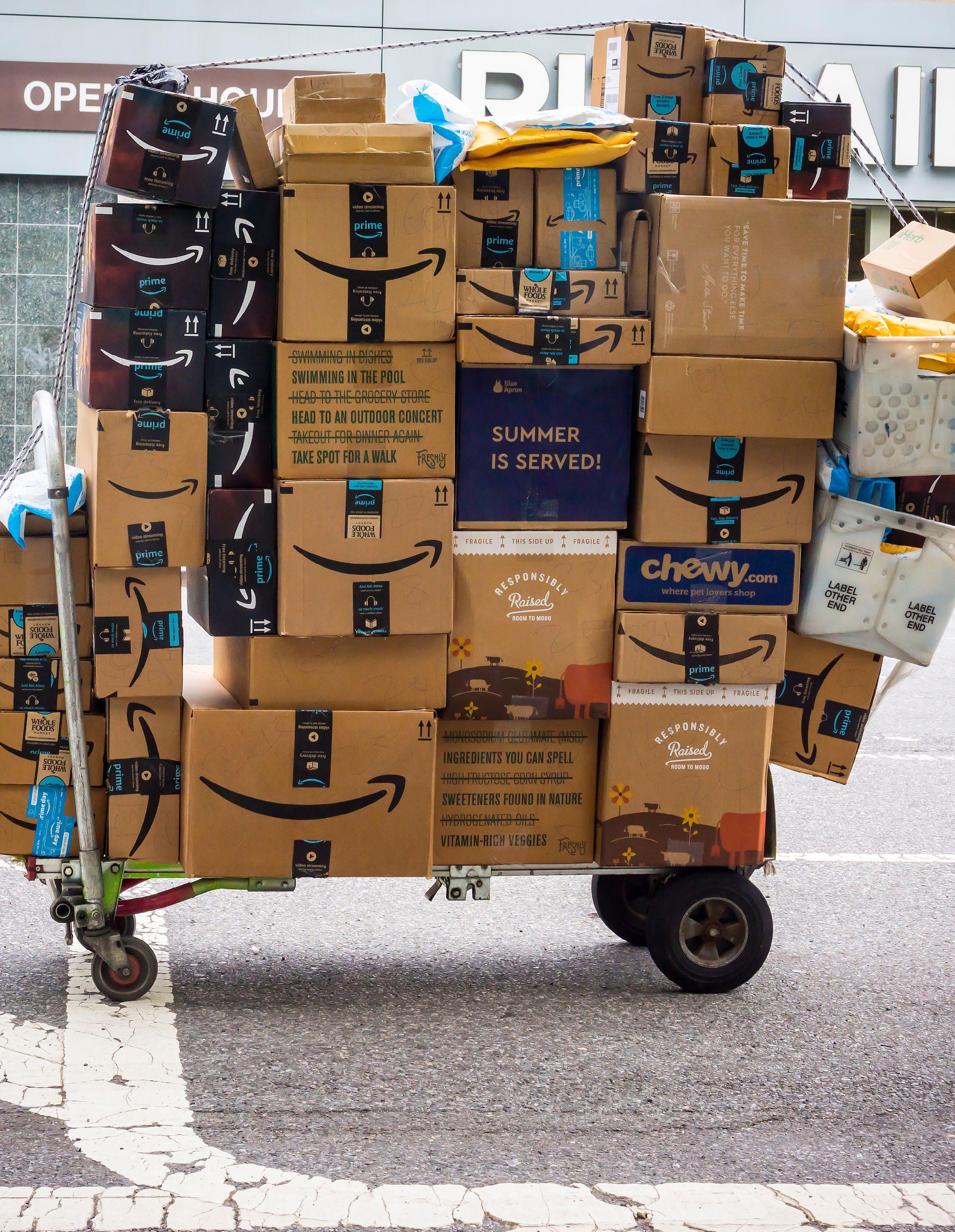
7 minute read
How Amazon is reducing its plastic packaging footprint
• Amazon has the solutions: it needs to implement them globally • Amazon’s elimination of single-use plastic packaging in India could be significantly reducing the company’s plastic pollution footprint • Amazon uses reusable packaging in select markets. It needs to do this everywhere • Amazon developed plastic-free alternatives to replace single-use plastic packaging
Oceana's estimate of Amazon's plastic footprint was substantially impacted by the company's actions in India. Oceana assumed in its analysis, that Amazon has reduced its single-use plastic packaging waste by 50% in India, which cut its estimated global plastic packaging waste significantly. Unfortunately, Amazon has not publicly released data regarding its reduction of plastic packaging in India, and customer data (such as unboxing videos by Amazon customers in India) make it clear that some single-use plastic packaging is still in use.
As Amazon writes in its 2020 sustainability report:
In India, Amazon eliminated single-use, thin-film plastics in packaging in 2020 by replacing plastic materials like bubble wrap and air pillows with paper cushions and introducing plastic-free, biodegradable tape. To reduce the need for packaging at all, we have developed a model for packaging-free shipping across more than 100 Indian cities, delivering orders in their original packaging using protective containers that delivery drivers can reuse.65
India’s e-commerce market is forecast to have sales of $61 billion in 2021, and market experts estimate this could more than double by 2025.66 In June 2018, India’s prime minister, Narendra Modi, and its central government pledged to ban single-use plastics by 2022.67 But in October 2019, the ban was delayed.68
Taking matters into his own hands, 16-year-old Delhi resident Aditya Dubey started a petition to stop Amazon and fellow Indian e-commerce giant Flipkart from using what the petition described as “excessive” plastic packaging in India69 and, through his legal guardian, pleaded to the country’s National Green Tribunal. The Tribunal then requested that the Indian Central Pollution Control Board take action, who in consequence informed Amazon that, in line with India’s Extended Producer Responsibility for plastic waste, “Primary responsibility for collection of (…) packaging is of Producers, Importers, and Brand Owners who introduce the products in the market. They need to establish a system for collecting back the plastic waste generated due to their products.”70
Amazon innovated and quickly took steps to reduce its plastic use in India. Amazon announced that it would use paper cushions in India to replace plastic dunnage, such as air pillows and bubble wraps in outer boxes across all its fulfillment centers.71 It also unveiled a plan to expand the Packaging-Free Shipping program and later reported that 40% of its orders were being shipped in their original boxes72 and not repackaged by Amazon.
On June 29, 2020, Amazon announced it had achieved a 100% successful transition away from single-use plastics in India, less than a year after its declaration to act. Unfortunately, it qualified this claim by noting that it still uses some plastic in packaging material, which it claims are 100% recyclable through the available collection, segregation, and recycling channels.73 In addition, Oceana’s searches of unboxing videos uploaded in the past year found several examples of plastic packaging in the packages opened by Amazon customers in India.
Because the ban took effect in the second half of the year – Oceana assumed in its estimate that Amazon India's plastic packaging footprint has at best halved to what it would be if solely calculated by market share. The company needs to provide data about its progress in India, clarify its definition of single-use plastic packaging, and expand this effective solution for reducing its plastic packaging footprint to the rest of the countries where it operates.
In late November 2021, news accounts reported74 that Amazon had pledged to cut its use of plastic packaging in Germany by the end of the year. Germany is one of the company’s largest markets – the company has a reported 53% market share in the country and ships hundreds of millions of packages in Germany annually.75 Amazon, in an operational note it shared with Oceana,76 said it will switch from plastic to delivering in “flexible paper-based bags” and other plastic alternatives and said this switch will apply to items shipped by Amazon and those shipped by third-party providers through Amazon. Amazon’s pledge to move away from single-use packaging in one of its largest markets shows it is possible to do this everywhere it operates around the world.
Amazon unboxing video published to YouTube on September 19, 2020 (note the Amazon.in logo on the top right). Source: Tech Buffett Samsung Galaxy M51 Unboxing - Amazon's First Sale Unit
AMAZON'S USE OF REUSABLE PACKAGING
Amazon in India is delivering food to customers in more than 300 cities77 and has announced that it delivers 60% of Amazon Pantry orders in reusable tote bags78 to reduce secondary packaging as of 2019. It is also using reusable crates to deliver individual shipments instead of plastic or corrugated boxes for delivery in Bangalore.79 Additionally, in the U.S., some Amazon Fresh food orders have been delivered in reusable totes,80 a solution that could be expanded to all other Amazon deliveries.
Coupang, the largest e-commerce company in South Korea, has dramatically expanded its use of reusable packaging with its Coupang Fresh business81 where customers can opt to use reusable eco bags that they return to their drivers. Coupang customers are also, according to the company, able to leave returns for the company’s delivery persons to pick up outside their front doors (without boxes and labels).82
Amazon has more than 200 million Prime customers around the world,83 and in Oceana’s recent survey of 1,400 Prime Members more than half reported shopping on Amazon several times a month.84 These are repeat customers who can accept and return reusable packages. According to recent reports, Amazon itself delivered 4.2 billion packages or 21% of all deliveries in the U.S. (making it a larger shipper of parcels than FedEx).85 Amazon can substantially increase its use of returnable packaging and significantly decrease its use of disposable single-use packaging.
Amazon is a world leader in innovation and has already created several alternatives to single-use plastic packaging.
Amazon’s lightweight padded paper mailer and other recent announcements Amazon’s packaging and materials lab has innovated and created a lightweight padded paper mailer. Amazon has previously reported that the paper mailer has been used hundreds of million of times.86 This mailer is made from 100% paper and employs a form of glue as a cushioning material that is made from the same material as the glue used in cardboard boxes and therefore it can be recycled as paper.
In its 2020 sustainability report,87 Amazon states, “We are expanding our use of paper padded mailers across North America to replace the use of mixed paper and plastic mailers by the end of 2022." Mixed paper and plastic mailers refer to paper envelopes with interior plastic padding. It is unclear what this means in terms of reducing the company’s plastic footprint (given the company’s lack of transparency) but considering Amazon’s recent dramatic increase in the use of mailers,88 this is seemingly a significant step. Amazon should share details about the new mailer's impact on plastic waste reduction and continue to aggressively replace plastic mailers with other viable alternatives. It should also use recycled paper to produce these mailers. Unfortunately, in testimony to the California Recycling Commission, Amazon representatives stated that it is not using recycled paper to produce this mailer because “Too much recycled content might compromise the integrity of that paper and its ability to not tear during the fulfillment process.”89
Amazon has recently announced further steps towards plastics reduction by replacing plastic pouches with paper envelopes in France90 and better recyclable paper packaging for groceries in the U.S.91,92 But even without a plastic outside, items in France may still be packaged with plastic bubble wrap or cushions as protective covers. And while certainly a step in the right direction, the reported plastic reduction in the U.S. would likely not even amount to 0.2% of Amazon's global plastic footprint as estimated by Oceana.
Frustration-Free Packaging Amazon’s main packaging initiative is its long standing “Frustration-Free Packaging”93 program. This effort is focused on reducing packaging by volume and weight. Amazon works with sellers who come up with packages specifically designed for Amazon (that use less material including plastic. This approach avoids shipping packaging designed for retail (and not for shipping). In its sustainability report,94 Amazon cites working with P&G in creating "the Tide Eco-Box" which it states uses 60% less plastic compared to the package it replaced.95
With “Frustration-Free Packaging”, vendors can choose to certify their packaging as “no [Amazon] over box required," meaning the products ship only in their original packaging or with an over box directly from the vendor.96
Amazon wrote, in its 2020 sustainability report that as of June 2021, more than 2 million products qualified under its Frustration-Free Packaging program.97 But, no data is also provided about the amount of plastic packaging this effort eliminates (or what percent of Amazon sales this figure represents). So, while this approach eliminates plastic, it is unclear what specific impact this program has on reducing Amazon’s plastic footprint. Amazon should continue to expand this program and be transparent about its impact on reducing plastic packaging.










